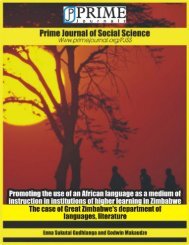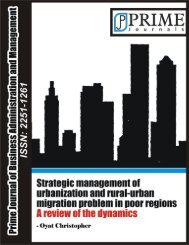See Full Article [pdf] - Prime Journals
See Full Article [pdf] - Prime Journals
See Full Article [pdf] - Prime Journals
You also want an ePaper? Increase the reach of your titles
YUMPU automatically turns print PDFs into web optimized ePapers that Google loves.
<strong>Prime</strong> Research on Biotechnology (PRB)ISSN: 2315-5299. Vol. 2(4), pp. 53-56, December 18 th , 2012www.primejournal.org/PRB© <strong>Prime</strong> <strong>Journals</strong><strong>Full</strong> Length ResearchHypoglycemic activity of aqueous extract of the bark ofBridelia ferruginea in normal and alloxan-induceddiabetic ratsAdewale OB and Oloyede OI1 Department of Chemical Sciences (Biochemistry unit), College of Sciences, Afe Babalola University, Ado-Ekiti, EkitiState, Nigeria.2 Department of Biochemistry, Faculty of Science, Ekiti State University, Ado-Ekiti, Ekiti State, Nigeria.Accepted 18 th October, 2012The hypoglycemic activity of the aqueous extract from stem bark of Bridelia ferruginea was investigated in both normaland alloxan-induced diabetic rats. Rats were made diabetic by the administration of alloxan (150mg/kg body weight)intraperitoneally. Fasting blood glucose level greater than 300mg/dl indicates diabetes mellitus. Diabetic rats weretreated with 100mg/kg of the extract. The extract significantly reduced the blood glucose level of normal rats at thetested dose 24 hours after oral administration (p< 0.05) from 45.00 + 2.65 to 32.67 + 1.53 mg/dl and also reduced theblood glucose level of alloxan-induced diabetic rats from 547.50 + 74.25 to 450.00 + 14.14 mg/dl. Glucose tolerance innormal rats was enhanced which shows that there is marked improvement in glucose utilization after administration ofthis extract. The result obtained in this study revealed the mechanism of hypoglycemic activity of Bridelia ferruginea torepair the β-cells that has been destroyed by the alloxan monohydrate within few hours. This implies that the aqueousextract from this plant stimulates the reduction of the blood glucose by acting directly as insulin or enhancing the releaseof insulin.Keywords: Hypoglycemic activity, Bridelia ferruginea, alloxan, glucose tolerance, insulin.INTRODUCTIONDiabetes mellitus is a chronic metabolic disordercharacterize by degeneration of carbohydrates, proteinand fat metabolism (O’Brien and Granner, 1996).Diabetes being a major degenerative disease is found inall parts of the world and it is becoming the third mostlethal disease of mankind and rapidly increasing(Ogbonnia et al., 2008). Hyperglycemia (high bloodsugar) is a condition in which an excessive amount ofglucose circulates in the blood plasma. This is generally aglucose level higher than 180 mg/dl. Hyperglycemiacauses many of the health problem associated withdiabetes such as heart disease, kidney and nervedamage. However, hypoglycemia (low blood sugar) ismost common among people with diabetes, as too muchinsulin can cause blood sugar levels to fall. However,hypoglycemia is a condition in which there is anabnormally low level of glucose (sugar) in blood. If leftuntreated, hypoglycemia can cause permanentneurological damage and death (Dailey, 2007; Bergqvistet al., 2008). Hypoglycemic agents have been used in themanagement of diabetes mellitus (DM).Insulin and oralhypoglycemic agents like sulphonylureas and biguanidesare still the major players in the management of thedisease. Due to lack of insulin, hyperglycemia andglycosuria almost invariably occur. The search for acurative agent against this disease resulted in theintroduction of several hypoglycemic agents. Some ofwhich are used therapeutically. However, various harmfulside effects and weak effectiveness of them made theiruse limited and the search to find more effective agentscontinues. Medicinal plants are increasingly being used inmost parts of the world as hypoglycemic agents (Farswanet al., 2009; Lee et al., 2009). Several plants and isolatedcompounds have been demonstrated to have antidiabeticpotentials (Li et al., 2004; Grover et al., 2000;Rahman and Zaman, 1989). One of them is taken forinvestigation in this study.Bridelia ferruginea is a tree belonging to the family
Adewale and Oloyede 54Euphorbiaceae. The genius Bridelia is made up of about60species scattered throughout Asia, Africa and Australia(Rashid et al, 2000). Bridelia ferruginea is commonlycalled “ira” and the bark “eepo ira” in Nigeria among theYorubas. It is used in some communities in Cameroon inthe traditional treatment of illness referring to the clinicaldiabetes condition (Njamen et al, 2003). Nutritionally,various parts of this tree are used in the treatment ofillnesses e.g. roots and branches has antibacterialproperties, roots to treat skin diseases, the leaves andthe decoction of the stem bark in the treatment ofdiabetes, diarrhea, dysentery, gastrointestinal disordersand rheumatic pains (Cimanga et al, 1999, Addae-Mensah and Achenback, 1985). B. ferruginea has beenfound to contain rutin (Rashid et al, 2000), which hasbeen shown to exhibit hypoglycemic activity (Onunkwo etal, 1996). The leaf extract was shown to contain naturallyoccurring secondary metabolites endowed with antidiabeticproperties (Njamen et al, 2003, Onunkwo et al,1996). The objective of this study was to examine thehypoglycemic effect of the bark of Bridelia ferruginea.MATERIALS AND METHODPlant materialsThe stem bark of Bridelia ferruginea tree was obtainedfrom Eniju farmland at Ijurin-Ekiti in Ijero LocalGovernment of Ekiti State, Nigeria. It was air-dried fortwenty-eight days, ground after removing the outermostlayer. The powdered material was then stored in sealedbottle at room temperature (37 0 C).ExtractionAqueous extract of stem bark of Bridelia ferruginea (5g)was extracted with 100 ml distilled water and stored inthe refrigerator at 10 0 C for 12hrs. The resulting filtratewas administered orally to the animals using an intubatorbased on the body weight and the dose (100mg/kg bodyweight).Chemicals usedAlloxan monohydrate and α-d-glucose (anhydrous) fromSigma Chemical Company, St. Louis, Mo, U.S.A. Distilledwater, methylated spirit, and one touch glucose strips.Each glucose strip contains the following reactiveingredients in the approximate concentrations: Glucoseoxidase -----14IU, Peroxidase -----11IU, 3-methyl-2-benzothiazolinone hydrazone hydrochloride ---0.06mg, 3-dimethylaminobenzoic acid------ 0.12mg.Laboratory animalsFemale albino rats weighing between 100-140g wereused for the study. The animals were obtained from theanimal house of the Department of Biochemistry,University of Ilorin, Nigeria. The animals were housed atthe Department of Biochemistry, Ekiti State University,Ado-Ekiti, and were acclimatized for a period of 7dayswith free access to pelleted feed and clean water. Therats were then grouped randomly into four with fouranimals in each. Alloxan monohydrate (150mg/kg bodyweight) was dissolved as 5% solution in distilled waterand injected intraperitoneally in previously overnightfasted rats to induce diabetes. After one hour animalswere allowed food and water ad libitum. After 72hoursBlood glucose levels were estimated by the glucoseoxidase method and animals having blood glucose levelsof more than 150mg/dl were selected for study.Sixteen female albino rats divided into four groups(n=4) designated: Group I normal control received onlydistilled water, group II received only aqueous extract ofthe bark of Bridelia ferruginea (100mg/kg body weight),groups III and IV were made diabetic by theintraperitoneal administration of alloxan monohydrate(150mg/kg body weight). Group III animals were treatedwith aqueous extract of B. ferruginea (100mg/kg bodyweight) and alloxan diabetic rats of group IV were kept asdiabetic control (untreated). Determination of fastingblood glucose Fasting blood glucose levels in bothnormal and alloxan-induced diabetic rats weredetermined routinely by the glucose oxidase method(using the digital one-touch glucometer). Blood sampleswere collected two hours after administration of theextract by cutting the tip of the tail of each rat. Rats withblood glucose level above 200mg/dl were considered tobe diabetic and were used in the study.Oral glucose tolerance testThe oral glucose tolerance test was carried out on normaland alloxan-induced diabetic untreated group at the sametime. The rats were administered orally with the aqueousextract of the bark of B. ferruginea at a dose of 100mg/kgbody weight after an overnight fast. Two hours later,glucose solution (2g/kg body weight) was administeredorally. Blood samples were collected prior to theadministration of the glucose load. Blood glucose valueswere determined at 30, 60, 90 and 120 minutes later. Theblood samples were taken by cutting the tip of the tail ofeach rat and the blood glucose levels were determinedroutinely by the glucose oxidase method.Statistical analysisAll data were expressed as means ± SD. Student’s t-testwas used to compare the mean values of test groups andcontrol. Differences in mean values were consideredsignificant at p < 0.05.RESULTS AND DISCUSSIONThe mean blood glucose levels of control and treated ratsat various time intervals after oral administration ofaqueous extract of the bark of Bridelia ferruginea areshown in table 1. These levels were compared with thevalues in control rats administered distilled water only.Theglucose levels of normal rats administered B.ferrugineaaltered blood glucose glucose were found to besignificantly (P
55 Prim. Res. Biotech.Table 1.0: Effect of 5% w/v aqueous extract of the bark of Bridelia ferruginea (100mg/kg body weight) on blood glucose (mg/dl) in normal rats.0hr 2hr 4hr 6hr 8hr 10hr 12hr 24hrControl 47.25+4.99 47.00+3.83 47.00+4.55 40.75+2.50 35.00+9.63 36.00+3.14 29.00+14.65 28.50+7.94Test 45.00+2.65 48.67+2.31 45.00+2.65 39.67+1.53* 39.33+5.13* 42.00+6.56 22.00+5.29* 32.67+5.51*Each value represents the mean + S.D from 4 ratsSignificant different from control: *P < 0.05Table 2.0: Effect of 5% aqueous extract of the bark of Bridelia ferruginea (100mg/kg body weight) on blood glucose (mg/dl) on alloxan-induceddiabetic rats.0hr 2hr 4hr 6hr 8hr 10hr 12hr 24hrControl 558.00+59.40 610.00+14.14 625.00+35.36 598.50+72.83 578.50+30.40 224.00+0.00 304.00+0.00 215.00+0.00Test 547.50+74.25 620.50+41.72 566.50+47.38 510.50+72.83 474.50+36.06 460.00+12.73 462.50+81.32 450.00+14.14Each value represents the mean + S.D from 4 ratsTable 3: Glucose values (mg/dl) during oral glucose tolerance test in normal and alloxan-induced diabetic untreated rats.0min 30mins 60mins 90mins 120minsControl 48.33+1.53 59.33+2.52 62.67+5.51 54.33+7.64 45.00+5.57Test (Normal) 51.00+0.00 54.33+7.09 47.00+2.65 51.00+2.65 45.00+2.65Test (Untreated) 484.67+17.60* 459.33+94.92* 540.33+69.79* 475.33+77.02* 497.33+86.95*Each value represents the mean + S.D from 4 ratsSignificant different from control: *P < 0.05Table 4: Growth response of Diabetic rats treated with aqueousextract of the bark of Bridelia ferruginea.Time 0hr 6hr 12hr 24hrControl 107 103 138 140Test 105 114 110 126This clearly shows that the 5% aqueous extract of thebark of B. ferruginea produces hypoglycemic effect by thestimulation of insulin release.The hypoglycemic effects ofBridelia ferruginea on the blood glucose of alloxaninduceddiabetic rats are shown in Table 2.0.Administration of 100mg/kg of 5%(w/v) aqueous extractof B. ferruginea produced a decrease in blood glucoselevel of rats. The hypoglycemic effect of the extract wasfelt from 6hours after administration. The blood glucoselevel of the treated animals reduced consistently from6hours to a period of 24hours after administration. Thisclearly shows that the 5% (w/v) aqueous extract of B.ferruginea seem to act by stimulating the release ofinsulin, as the alloxan treatment causes permanentdestruction of the β-cells.The glucose tolerance of the rats (normal anduntreated diabetic) after oral glucose loading is shown inTable 3.0. Administration of 5% (w/v) glucose solutioninto control rats (normal) altered the blood glucose levelcompared to the basal value. Administration of 5%glucose solution following the administration of B.ferruginea produced a decrease in blood glucose levelcompared to the basal value (from 51.00 + 0.00 to45.00 + 2.65).In alloxan-induced diabetic untreated group,administration of the glucose solution produced asignificant increase in the blood glucose level after30mins. It can be assumed that this extract may stimulateinsulin secretion in a glucose-dependent manner(MacDonald and Wheeler, 2003). On the other hand, thehypoglycemic effect of the extract in the glucose fed ratsmay be accounted in part, by an inhibition of intestinalglucose absorption and the stimulation of the glucagonlikepeptide (GLP-1) which is also a glucose-dependentinsulin secretion (Goke et al, 1995).The growth response of diabetic rats treated withaqueous extract of B. ferruginea is shown in Table 4.0.Treatment of alloxan-induced diabetic rats with theextract for 24hrs resulted in weight gain compared withthe loss in weight of the control untreated at 6hrs. Thisindicates the hypoglycemic effect of B. ferruginea sincediabetes is associated with weight loss. In alloxaninduceddiabetes, a massive reduction in insulin release(due to the action of the alloxan which destroys theinsulin-secreting site β-cells of the islets of langerhans)produces hyperglycemia (Dunn et al, 1943). This presentstudy clearly shows that the treatment with rats. Thepossible mechanism(s) by which significantly that is at 6,8,12 and 24 hours, blood action may be due to possiblepancreatic secretion of insulin from existing β-cells, toenhance transport of blood glucose to peripheral tissues,or reduced glucose absorption from the gastrointestinaltract. It is therefore, hypothesized that B. ferrugineacontains one or more types of hypoglycemic principles.
Adewale and Oloyede 56CONCLUSIONThe study suggests the hypoglycemic activity of B.ferruginea in alloxan-induced diabetic rats and normalrats, and supports the potential utility of B. ferruginea inhuman healthcare for the treatment of diabetes mellitus.REFERENCESAddee-Mensah I, Achenbach H (1985). Terpenoids andflavonoids of Bridelia ferruginea. Phytochemistry. 24:1817-1819.Bergqvist AG, Schall JI, Gallagar PR (2008). Fastingversus gradual intiation of the Ketogenic diet: aprospective, randomized clinical trial of efficacy.Epilepsia, 46(11), 1810-1819.Dunn JS, Kirkpatrick J, Mcletchie NGB, Telfer SV (1943).Necrosis of the islets of Langerhans producedexperimentally. JPath bact. 55: 245-257.Dailey G (2007). Assessing glycemic control with selfmonitoringof blood glucose and hemoglobin A(Ic)measurements. Mayo Clinical Procurement, 82(2),229-235.Farswan M, Mazumder PM, Percha V (2009). Protectiveeffect of Cassia glauca Linn. On the serum glucoseand hepatic enzymes level in streptozotocin inducedNIDDM in rats. Indian J. Pharmacol., 41(1), 19-22.Goke B, H Fuder, G Wieckhorst, U Theiss and E Striddleet al. (1995). Voglibose (AO-128) is an efficient α-glucosidase inhibitor and mobilizes the endogenousGLP-1 reserve. Digestion, 56: 493-501.Grover JK, Yadav S and Vats V (2000). Medicinal plantsof India with anti-diabetic potential. J. Ethnophamacol.,81, 81-100.Lee SI, Oh SH, Park KY, Park BH and Kim SD (2009).Antihyperglycemic effects of fruits of privet (Ligustrumobtusifolium) in streptozotocin-induced diabetic rats feda high fat diet. J. Med. Food, 12(12), 109-117.MacDonald PE and Wheeler MB (2003). VoltagedependentK+ channels in pancreatic beta cells: role,regulation and potential as therapeutic targets.Diabetologia 46: 1046–1062.Njamen D, Tsala DE, Mbanya JC, and Massi-Benedetti M(2003). New glucose-lowering therapies. A screeningof the anti-diabetic effects of the methanol extract ofthe leaves of Bridelia ferruginea (Euphorbiaceae)bonsucrose-induced glucose intolerance in rats. 2358.O’Brien RM And Granner DK (1996). Regulation of geneexpression by insulin. Physiological rev; 76:1109-1161.Ogbonnia SO, Odimegu JI, Enwuru, VN (2008).Evaluation of Hypoglycemic and hypolipidemic effectsof ethanolic extracts of Treculia africana Decne andBryopyllum pinnatum Lam. and their Mixture onstreptozotocin (STZ)- induced diabetic rats. Afr. J.Biotech., 7(15), 2535-2539.Onunkwo GC, Akah PA and Udeala OK (1996). Studieson B. ferruginea leaves (1). Stability and hypoglycecactions of the leaf extract tablets. Phytother Res. 10:418-420.Rahman, A-Ur. and Zaman, K. (1989). Medicinal plantswith hypoglycemic activity. J. Ethnophamacol., 26, 1-55.Rashid MA, Gustafson K.R., Cardellina, J.H. and Boyd,M.R (2000). A new podophyllotoxin derivative fromBridelia ferruginea. Nat. Prod. Let. 14: 285-292.


![See Full Article [pdf] - Prime Journals](https://img.yumpu.com/41607332/1/500x640/see-full-article-pdf-prime-journals.jpg)


![See Full Article [pdf] - prime journals limited](https://img.yumpu.com/49292987/1/190x245/see-full-article-pdf-prime-journals-limited.jpg?quality=85)



![See Full Article [pdf] - Prime Journals](https://img.yumpu.com/44526114/1/190x245/see-full-article-pdf-prime-journals.jpg?quality=85)


![See Full Article [pdf] - prime journals limited](https://img.yumpu.com/42270022/1/190x245/see-full-article-pdf-prime-journals-limited.jpg?quality=85)

![See Full Article [pdf] - Prime Journals](https://img.yumpu.com/41231982/1/190x245/see-full-article-pdf-prime-journals.jpg?quality=85)

